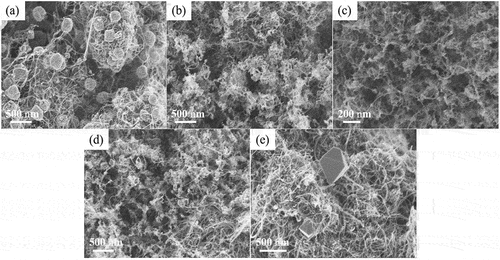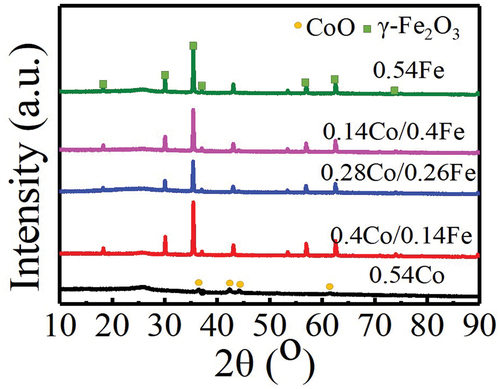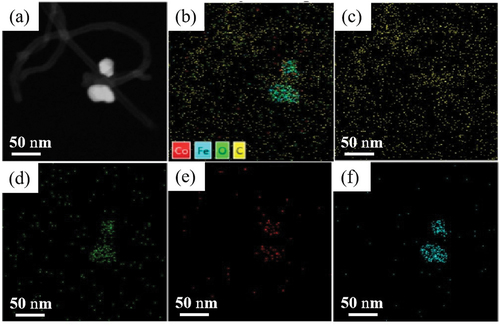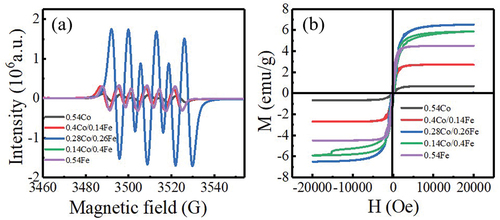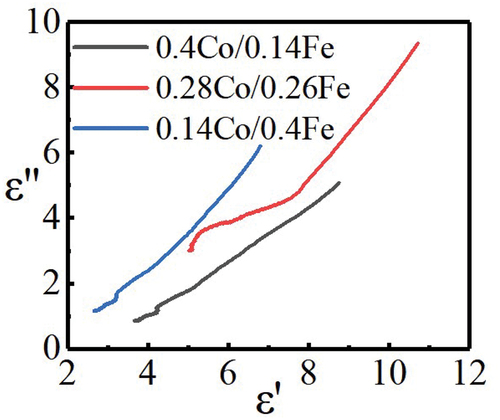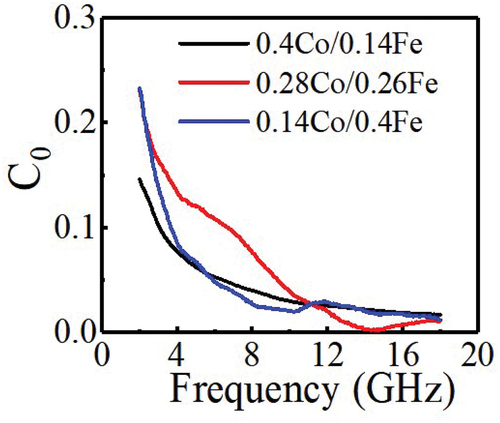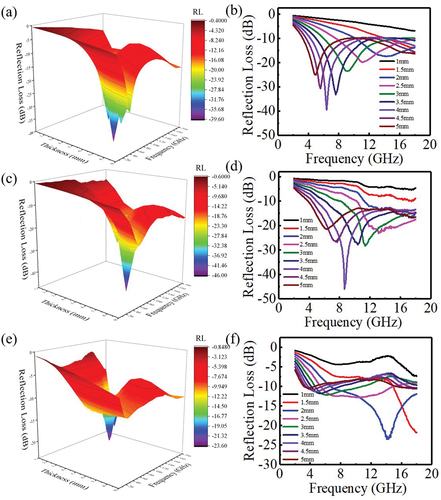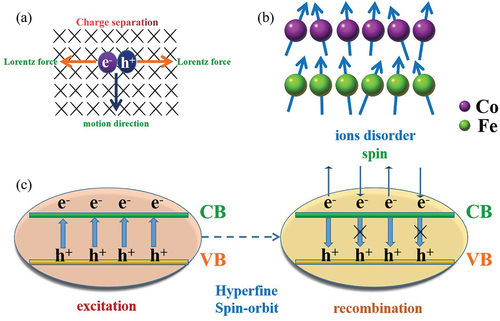 ?Mathematical formulae have been encoded as MathML and are displayed in this HTML version using MathJax in order to improve their display. Uncheck the box to turn MathJax off. This feature requires Javascript. Click on a formula to zoom.
?Mathematical formulae have been encoded as MathML and are displayed in this HTML version using MathJax in order to improve their display. Uncheck the box to turn MathJax off. This feature requires Javascript. Click on a formula to zoom.ABSTRACT
The structure design, performance analysis, and process optimization of CNT/MOF-derived hierarchical composite play an important role in the development of high-performance microwave absorbing materials. Herein, the preparation, morphology evolution, and electromagnetic wave absorption mechanism of CNT/MOF-derived hierarchical composite were systematically investigated. The regulation mechanism was revealed by studying the changes in the morphological characteristics, electromagnetic properties, and microwave absorbing performance of CNT/MOF-derived hierarchical composite under different process parameters. The results show that the morphological characteristics and interface bonding between CNT and MOF have a great impact on the absorptive capacity. The composite with composition of 0.28Co/0.26Fe has a maximum absorption of −46 dB at 8.6 GHz and a thickness of 4 mm. In addition, the absorption band with reflection loss values of less than −20 dB can be operated with this thickness between 7.15 and 10.18 GHz, showing excellent absorbing ability and electromagnetic wave bandwidth. The regulation mechanism of CNT/MOF-derived hierarchical composite mainly depends on the effect of Lorentz force, the ion disorder of CoO-Fe2O3 heterojunction, and the spin polarization mechanism of free electrons. This study further improves the corresponding theoretical basis and new design principles, which provides technical support for the development of high-performance absorbing materials.
Graphical abstarct
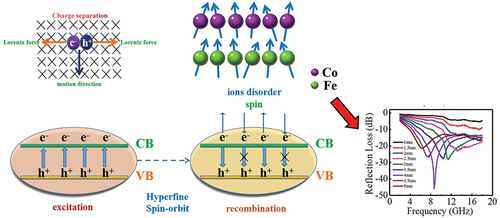
1 Introduction
Under the background of the rapid development of electronic communication technology, the increasing demand for intelligent electronic equipment and the continuous expansion of the 5 G network application market promote the update and iteration of various electronic products [Citation1–4]. Furthermore, human will face the gradually complex electromagnetic environment in the upcoming 6 G network [Citation5]. Therefore, the aggravations of electromagnetic radiation and interference caused by the heavy use of electronic products affect the normal operation of electronic equipment and human health [Citation6–9]. Especially, since the outbreak of COVID-19, various online works have continuously emerged, leading to more serious electromagnetic pollution. Besides, the electromagnetic waves have been used for many aspects in scientific research, such as microwave heating and so on. Harmful electromagnetic wave can accuracy of experimental data [Citation10–15]. To alleviate this problem, the development of high-quality absorbers has become an increasing consensus in dealing with electromagnetic pollution. At this point, the theoretical basis and design ideas of the system need to be improved and supplemented. Therein, the combination of dielectric and magnetic materials is an effective strategy to strengthen the storage and attenuation ability of electromagnetic energy [Citation16–19]. By adjusting the electromagnetic parameters such as permittivity and permeability, the impedance matching and attenuation ability can further be enhanced. The integration of dielectric and magnetic properties can effectively coordinate the relationship between permittivity and permeability, thereby optimizing the microwave absorbing performance [Citation20–23]. However, the morphology evolution, bonding mode, and electromagnetic wave absorption mechanism are still unclear.
Generally, carbon nanotubes (CNTs) can serve as dielectric materials due to their unique tubular structure and excellent electrical performance [Citation24–26]. The existence of hopping electrons between different tube walls/tubes can greatly accelerate the electronic transmission capability, which markedly increases the conductivity loss of electromagnetic wave [Citation27]. MOF-derived metals or metal oxides can serve well as magnetic nanoparticles. The porous properties of the MOF precursors can be maintained to a great extent, extending the transmission path of the electromagnetic wave [Citation28–30]. Therefore, the CNT/MOF-based hierarchical composites are typical candidates as electromagnetic wave absorbers. In the structural design of CNT/MOF-based hierarchical composites, the growth mechanism, existence form, and bonding modes of each component are significant parts in the construction of compound structure. Under normal circumstances, the bonding modes are divided into covalent and noncovalent bonding. In theory, covalent bonding can improve the electron transfer between different components, which is conducive to conduction loss. Noncovalent bonding can enhance the polarization loss. Consequently, the designed complex structure with multiple bonds between CNT and heterostructures can ameliorate the attenuation ability comprehensively. In addition, the morphology and electromagnetic characteristics of MOF-based component are another key factor. MOF-based components require semiconductor and magnetic characteristics to ensure electromagnetically coordinated regulation. Moderate defects and active functional groups are also necessary to produce abundant active sites that serve as the polarization centers.
There are two main methods for the structural design of CNT/MOF-based composites, the absence of CNT [Citation31,Citation32] and the inclusion of CNT [Citation33,Citation34] in the reaction mixture. For the former, the production and growth of CNT component stem from the decomposition of hydrocarbons, including organic ligands and other additives. The transformation of metal ions into metal or metal oxide nanoparticles can be used as a catalyst to accelerate the growth of CNT during heat treatment. However, the morphology and growth trajectory of CNT are difficult to grasp and control. The latter is relatively feasible and predictable, but excessive impurity carbon phase may be produced, which is detrimental to the formation of compound structure. Therefore, it is essential to explore the factors affecting the growth and evolution of impurity carbon phase. Among them, the heat treatment system and the ratio of bimetallic ions are the principal potential factors.
Based on the reasons mentioned above, this paper studied the preparation, morphology evolution, and electromagnetic wave absorption mechanism of CNT/MOF-derived hierarchical composite. The composite was designed by a two-step method. First, the CNT/MOF precursors were prepared by hydrothermal method, then the corresponding derivatives were obtained by heat treatment. The preparation process was further designed and optimized under the guidance of crystal growth and macro-electromagnetic theory. The exploration of preparation conditions mainly was focused on the selection of MOF materials, surfactant, reactant ratios, and so forth. Meanwhile, the influence mechanism exploration of heat treatment process through the combination of theoretical analysis and experiment validation was also conducted. The regulation mechanism was revealed by studying the changes in the morphological characteristics, electromagnetic properties, and microwave absorbing performance of CNT/MOF-derived hierarchical composite under different process parameters.
2 Experimental principle and method
2.1 Structural design of CNT/CoFe-MOF-74 composites
First, according to the previous literatures, the surface functionalization of CNT was carried out by acidification and oxidation treatment [Citation35]. Second, the CNT/CoFe-MOF-74 composite materials were prepared by solvothermal method. The 0.03 g CNT with different Co2+/Fe3+ ratio and 0.1 g PVP (polyvinyl pyrrolidone) were dissolved into 80 ml DMF. The additive amounts of corresponding Co and Fe salt are shown in Table S1. Then, the mixture was stirred for 0.5 h and ultrasonically dispersed for 4 h, so that Co2+/Fe3+ could be fully entangled on the CNT surface. Finally, 0.2 g of terephthalic acid was added into the suspension and with constant stirring transferred to the autoclave and heated to 160°C for 12 h. The products were separated, rinsed with DMF and ethanol several times, and dried to obtain the CNT/CoFe-MOF-74 samples with different Co2+/Fe3+ ratios.
2.2 Preparations of CNT/CoFe-MOF-74 derivatives
The as-prepared CNT/CoFe-MOF-74 samples were transferred into the tube furnace and annealed at 600°C. The heat treatment process was conducted in an argon atmosphere. The heating rate and the holding time were 5°C/min and 5 h, respectively. Subsequently, the materials were naturally cooled to room temperature. The samples were marked as 0.54Co, 0.4Co/0.14Fe, 0.4Co/0.14Fe, 0.28Co/0.26Fe, 0.14Co/0.4Fe, and 0.54Fe.
2.3 Research method and relevant equipment of electromagnetic wave absorption mechanism
The exploration of electromagnetic wave absorption mechanism was based on the analysis of microstructure characteristics, electromagnetic parameters, and the evaluation of microwave absorption performance. The formation mechanism of CNT/CoFe-MOF-74 derivatives was revealed by XRD (Cu Kα radiation, λ = 1.5406 Å, 40 A, 40 kV), SEM (Quanta PEG 250 field emission scanning electron microscope), TEM (JEM2100F transmission electron microscope), Raman microscope spectrometer (HORIBA Scientific, excitation wavelength = 532 nm), and X-ray photoelectron spectrometer (Thermo Fisher, k-alpha). On this foundation, the absorbing mechanism was studied by the analysis of relevant electrical and magnetic properties, which involved electron paramagnetic resonance spectrometer (EPR, E500, Bruker) and hysteresis effects (physical property measurement system, SQUIR, Quantum Design). According to the transmission line theory, the evaluation of microwave absorption performance was conducted by investigating the electromagnetic parameters and reflection loss test (vector network analyzer, Agilent, PNA-N5244A) [Citation36,Citation37]. The procedure of sample preparation is as follow: the sliced paraffin and the materials were mixed in the ratio of 1:3. After heating and melting, the mixed material was pressed into a ring sample (outer diameter: 7 mm, an inner diameter: 3 mm, and a thickness: 2 mm) by a mold.
3 Results and discussion
3.1 Morphology evolution of CNT/CoFe-MOF-74-base composites
The morphology evolution of the as-prepared samples is revealed by investigating the changing laws of morphological characteristics with different Co/Fe ratios during heat treatment. After solvothermal treatment, the colors of the supernatants are different during the filtration (Fig. S1), which indicates the strong interaction between Co2+ and Fe3+ during the solvothermal process. The SEM images of CNT/CoFe-MOF-74 composites are shown in . The Co/Fe ratio have a great impact on the morphology. The irregular framework structure for the 0.54Co sample ()) can be clearly found. The size of Co-MOF is about 1–3 µm, showing poor uniformity. The regularity has slightly improved after the introduction of Fe as shown in ). Interestingly, the morphology and size of MOF particles are significantly different in the 0.28Co/0.26Fe sample ()). The CoFe-MOF presents approximately orthorhombic structure. It can be seen that the MOF particles are uniformly distributed, and their size is greatly reduced (about 50–100 nm). Then the 0.4Co/0.26Fe presents a cubic structure, and the size is increased (about 200–300 nm) as manifested in ). At last, the size of 0.54Fe samples is further increased (about 1 µm) ()). As a result, when the content of Co is close to Fe, the size of the MOF particles is the smallest.
Figure 1. SEM images of CNT/CoFe-MOF-74: (a) 0.54Co, (b) 0.4Co/0.14Fe, (c) 0.28Co/0.26Fe, (d) 0.14Co/0.4Fe, and (e) 0.54Fe.
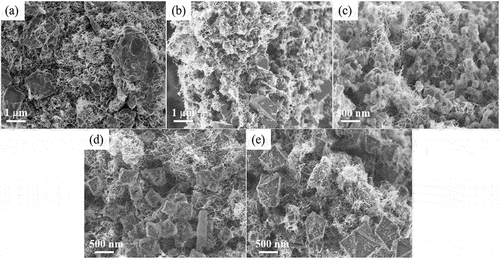
After the heat treatment process, further changes in morphology can be clearly observed in . The Co-MOF derivatives are nearly spherical particles with a diameter of 100 nm ()). However, the sizes of CoFe-MOF derivatives are reduced dramatically (about 10–50 nm) from ). In ), 0.4Co/0.14Fe and 0.14Co/0.4Fe have agglomeration, and accumulation of derivative particles occur to a certain extent. The derivatives have optimal distribution and low agglomeration effect in the 0.28Co/0.26Fe, which exhibit excellent uniformity. The derivative particles are bound to the surface of CNT, presenting a kebab-like structure ()). As for 0.54Fe, the derivative has an orthorhombic structure, showing a smooth surface by comparing ) and )). For this point, the Co/Fe ratio has a significant impact on the nucleation and growth of derivatives. When the amount of Co and Fe is close, the particles have more uniform distribution and less size.
3.2 Phase composition and element distribution of derivatives
The phase composition of CNT/CoFe-MOF-74 derivatives is studied by the XRD pattern in . The samples contain the diffraction peaks of γ-Fe2O3 (JCPDS No. 89–5892) and CoO (JCPDS, No. 48–1719) [Citation38,Citation39]. The crystallinity of γ-Fe2O3 is obviously better than that of CoO. The γ-Fe2O3 peaks of 0.4Co/0.14Fe are sharper and stronger than the other peaks. With the increase of Fe content, the peak is obviously weakened and gradually strengthened, indicating that the Co element has an important effect on the crystallinity of γ-Fe2O3.
shows the TEM images of 0.28Co/0.26Fe. The micro-morphology of the derivative particles can be clearly seen in ). The interface between CNT and derivative particles can be found in the corresponding HRTEM images in zone b ()). The interplanar spacing of 0.37 nm correspond to the (002) plane of CNT [Citation40]. ) presents the morphology of the derivative particles at high magnification, and the corresponding HRTEM results of the d, e, f region are observed in ). Two lattice planes with d-spacing of 0.213 and 0.25 nm are attributed to the CoO (200) and γ-Fe2O3 (110) planes, respectively [Citation41,Citation42], indicating that the derivative particles consist of CoO and γ-Fe2O3. The interface of CoO-Fe2O3 heterojunction is found in ), implying the strong binding ability between CoO and γ-Fe2O3.
Figure 4. TEM and HRTEM images of 0.28Co/0.26Fe: (a) the morphology at low magnification, (b) the corresponding HRTEM at b region, (c) the morphology of c region at high magnification, and (d), (e), and (f) the corresponding HRTEM at d, e, f regions.
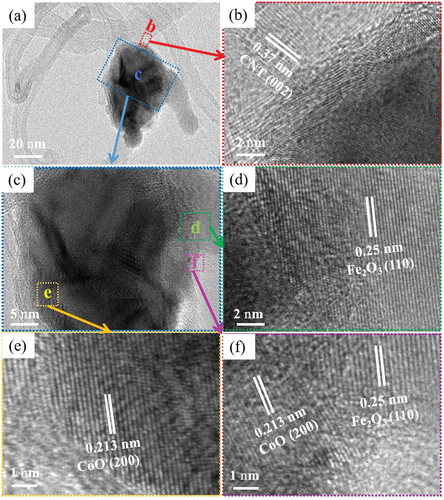
The element distribution of the derivative is investigated by EDS analysis as shown in . The electron and layered images are manifested in ), and the composite structure can be clearly observed, which is consistent with the SEM and TEM results. ) presents the corresponding distributions of C, O, Co, and Fe elements, proving that the derivative particles mainly consist of Co, O, and Fe elements.
3.3 Interaction mechanism and valence states of CNT/CoFe-MOF-74 derivatives
The Raman spectrum is presented in ) to reveal the interaction mechanism between CNTs and derivatives, which is investigated by the graphitic degree of carbon. The D peak represents the disorder or sp3-bonded carbon atoms, while the G peak is the in-plane stretching vibration or graphitization degree of sp2. The ratio of ID/IG is used to measure the carbonized degree of composite materials [Citation43]. The ID/IG values of 0.54Co, 0.4Co/0.14Fe, 0.4Co/0.14Fe, 0.28Co/0.26Fe, 0.14Co/0.4Fe, and 0.54Fe are 0.95, 0.94, 0.99, 0.99, and 0.98, respectively. The ID/IG values of 0.28Co/0.26Fe and 0.14Co/0.4Fe are higher than the other values, 0.99, 0.99, which means that 0.28Co/0.26Fe and 0.14Co/0.4Fe have more disorder or sp3-bonded carbon atoms and low graphitization degree. ) shows the TG curves of CNT/CoFe-MOF-74. It can be clearly found that the inflection points of all curves are close to 480°C and then decrease gradually. The inflection points reappear at the corresponding temperature point. The inflection points at 480°C are mainly caused by the decomposition of terephthalic acid and reducing of Co/Fe ions. We can clearly find that the inflection points of 0.54Co are higher than those of the other samples, indicating the poor decomposition of terephthalic acid and reduction ability. With the addition of Fe ions, the process of decomposition and reduction is improved due to the unique electronic configuration (Fe2+: 3s2 3p6). The electrons in p-orbital are easy to loss and become stable 3p5 configuration, resulting in generating Fe3+. Nevertheless, the reaction is not complete due to the faster heating rate. This task will require several hours of heat treatment process (5 h). The second inflection points are attributed to the fragmentation of the remaining ligand molecules.
Figure 6. (a) Raman spectrum of the CNT/CoFe-MOF-74 derivatives and (b) the TG curves of CNT/CoFe-MOF-74.
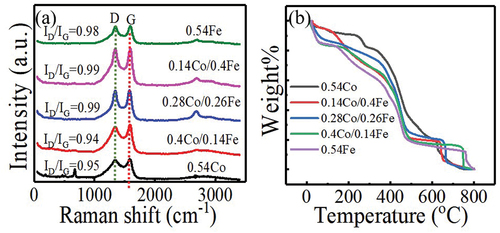
The valence states of 0.28Co/0.26Fe were investigated by XPS experiment. The high resolution spectra are given in . The peaks of Co 2p spectrum ()) locked at 780.8 and 796.7 eV belong to Co 2p3/2 and Co2p1/2, respectively, Meanwhile, there are two satellite peaks at 785.9 and 802.5 eV, confirming the existence of Co2+ [Citation44]. In the Fe2p XPS spectrum, the peaks at 723.5 and 710.6 eV are attributed to Fe2p1/2 and Fe2p3/2, indicating the production of Fe2O3 [Citation45]. The spectra of O1s are Co-O/Fe-O (529.2 eV), C-O (530.8 eV), and O = C-O/C-OH (532.2 eV). The corresponding C1s spectrum can be deconvoluted into three symmetric peaks of C-C (284.03 eV), C-O (285.4 eV), and C = O (287.9 eV).
3.4 Analysis of the electromagnetic characteristics of CNT/CoFe-MOF-74 derivatives
The electromagnetic characteristics of CNT/CoFe-MOF-74 derivatives mainly include unpaired electron concentration and hysteresis loss, as presented in . The unpaired electron concentration is characterized by EPR measurement ()). The signal intensity of 0.28Co/0.26Fe is stronger than that of the others, indicating the high unpaired electrons and free radicals concentration. Hence, the electron mobility and transmission ability of 0.28Co/0.26Fe are significantly better than the others. ) is the hysteresis loops of the as-prepared samples. Similarly, the 0.28Co/0.26Fe has a higher saturation magnetization, which is attributed to the cation disorder. In summary, the ratio of Co/Fe plays a role in the unpaired electron concentration and hysteresis loss, and 0.28Co/0.26Fe shows excellent electromagnetic characteristics.
3.5 Analysis of the relation between electromagnetic parameters
According to the analysis of phase composition, morphological, and electromagnetic characteristics, it can be concluded that 0.4Co/0.14Fe, 0.28Co/0.26Fe, and 0.4Co/0.14Fe have good composite effect. For this reason, three samples are selected to conduct the analysis of electromagnetic parameters and evaluation of microwave absorption performance. In general, the change law between electromagnetic parameters has a significant influence on the revelation of electromagnetic wave absorption mechanism, which is mainly based on the complex permittivity and permeability [Citation46,Citation47]. The real part represents the storage capacity of electromagnetic wave, and the imaginary part is the attenuation ability. Guided by Debye, eddy current theory, and so forth, the corresponding models reveal dielectric relaxation, eddy current loss, natural, and exchange resonance behaviors. The complex permittivity and permeability in the frequency range of 2–18 GHz are shown in . The real part ɛ’ decreases with increasing of frequency, which is attributed to the frequency diffusion effect ()) [Citation48]. The ɛ’ values of 0.4Co/0.14Fe, 0.28Co/0.26Fe, and 0.14Co/0.4Fe are 5.08–10.7, 3.66–8.81, and 2.67–6.86, respectively. The imaginary part ɛ” of the as-prepared samples is similar to ɛ’, and its value is slightly lower than that of the real part ()). Consequently, the 0.28Co/0.26Fe shows excellent electric storage and loss capacity. However, the characteristics of the permeability curve are remarkably different. The μ’ value of 0.28Co/0.26Fe first decreases and then increases with the increase of frequency, and it is lower than 0.4Co/0.14Fe ()). Furthermore, the μ’ value of 0.28Co/0.26Fe is higher than 0.14Co/0.4Fe at 2–7 GHz and lower than 0.14Co/0.4Fe at 7–18 GHz. Beside the slight fluctuation within a narrow range especially for the 0.4Co/0.14Fe, the existence of multiple resonance phenomenon can be found. ) exhibits the μ” curve of the as-prepared samples. The 0.28Co/0.26Fe shows a high μ” value at 2–11 GHz and a poor magnetic loss at 11–18 GHz. The corresponding loss tangent curves are demonstrated in ). The tanσɛ values of 0.4Co/0.14Fe and 0.14Co/0.4Fe decrease with the increase of frequency, and the values of 0.14Co/0.4Fe are higher than those of 0.4Co/0.14Fe in the entire frequency range. However, the values of 0.28Co/0.26Fe and 0.14Co/0.4Fe are very close at 2–6 GHz, and 0.28Co/0.26Fe has higher values in other frequency range. Accordingly, the 0.28Co/0.26Fe possesses the highest values of tanσμ at 2–10 GHz, while the values are poor in other frequency ranges. As a result, the attenuation of electromagnetic wave is attributed to the synergistic effect between the magnetic and dielectric loss for 0.28Co/0.26Fe. The complex permittivity and permeability is largely determined by the uniform distribution, less size, and impurity carbon atom based on SEM and Raman analysis. The electronic transmission capability can be promoted obviously, which leads to the more magnetic dipole.
Figure 9. The real part (a) and imaginary part (b) of complex permittivity, real part (c) and imaginary part (d) of complex permeability and the dielectric loss tangent (tanσɛ = ɛ”/ɛ’) (e) and magnetic loss tangent (tanσμ = μ”/μ’) values (f) of samples.
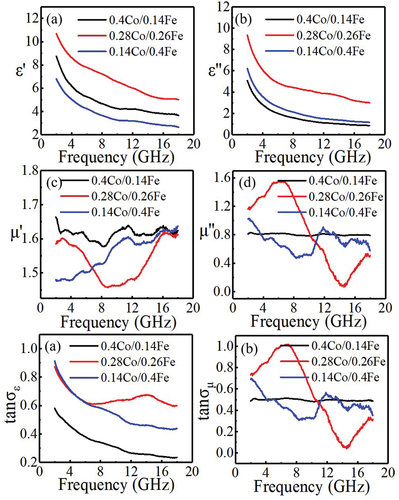
The mechanism of dielectric relaxation behavior mainly includes conduction and polarization loss, which can be described by Debye theory [Citation29], and the structures can be analyzed by the Cole–Cole semicircle model. The relationship of ɛ’ and ɛ” can be expressed as follows:
where ɛs and ɛ∞ are defined as static permittivity and relative dielectric permittivity under high-frequency limit. Hence, the curves of ɛ’-ɛ” are similar to semicircles under the existence of polarization loss theoretically. As depicted in , the semicircles of all samples are not obvious, indicating that the conduction loss plays a central role in the electrical loss of electromagnetic wave. The abundant carbon defects and ion disorder will lead to longer transmission path of electrons, which accelerate the conduction loss by long range interaction.
According to the results of complex permeability, the 0.28Co/0.26Fe has good magnetic loss ability in the low frequency range, which is another indispensable part for the enhancement of electromagnetic wave absorption performance. As a general rule, the exploration of magnetic loss mainly involves hysteresis and eddy current loss, natural, and exchange resonance [Citation49]. The hysteresis loss has been revealed by the H-B curves ()). The eddy current loss, natural, and exchange resonance can be analyzed by investigating the relationship between eddy current constant and frequency (C0-f), expressed as equation [Citation50]:
As displayed in , the C0 of all samples first drastically reduces and then become flat. The C0 values of 0.28Co/0.26Fe are higher than the other two samples at 2–11 GHz and the curves are steep, indicating that the magnetic loss mainly stems from natural and exchange resonance. Correspondingly, the flat regions are attributed to the eddy current loss.
3.6 Evaluation of electromagnetic wave absorption performance
) displays the three-dimensional diagrams of reflection loss with thickness and frequency, and the corresponding three-dimensional curves are exhibited in ). The minimum RL value of 0.4Co/0.14Fe is −39.6 dB at 6.36 GHz with the thickness of 2 mm, as shown in ). The 0.28Co/0.26Fe composite has a maximum absorption of −46 dB at 8.6 GHz with a thickness of 4 mm ()). In addition, the absorption band with RL values less than −20 dB can be manipulated between 7.15 and 10.18 GHz with this thickness. The sample exhibits excellent absorbing ability of electromagnetic wave. With the further increase of Fe content, the absorbing ability drastically reduces as shown in ). Therefore, the structure and microwave absorbing performance of CNT/CoFe-MOF-derived hierarchical composite can be effectively regulated by adjusting the ratio of Co/Fe. The synergistic mechanism between Co and Fe elements play a role in the crystallinity, phase distribution, morphology characteristics, and relevant properties.
3.7 The formation and electromagnetic wave absorption mechanism
3.7.1 The description of formation mechanism
The formation of 0.28Co/0.26Fe are mainly divided into the following stages: First, the Co and Fe ions are tethered on the CNT surface by electrostatic interaction due to the defects and active functional groups on the CNT surface. Second, Co and Fe ions coordinate with terephthalic acid ligands to form secondary building unit. Third, the structural units are used as nucleation sites to assemble into a MOF structure. Finally, after the heat treatment process, the ligands are decomposed and the metal ions are converted into corresponding metal oxides by the carbothermal reduction reaction. Throughout the process, the introduction of bimetallic ions have a great impact on the coordination and nucleation growth of the MOF structure. On the one hand, the existence of bimetallic ion can accelerate the coordination and nucleation of MOF particles, contributing to a smaller size and better distribution. On the other hand, bimetallic-MOF can produce more lattices and the impurity carbon phases are produced by the heat treatment process, leading to a low graphitization degree. Furthermore, the MOF derivatives are the CoO-Fe2O3 heterojunction. The Fe2O3 has higher crystallinity. There are a few impurity carbons on the heterojunction surface.
3.7.2 The revelation of electromagnetic wave absorption mechanism
The features of CoO-Fe2O3 heterojunction are the key factor for electromagnetic wave absorption. Hence, the band gap width of the samples are investigated by UV–Vis ()) and the plots of (Ahv)2 vs. photon energy ()). We can clearly find that the band gap width is almost the same and exhibits semiconductor properties well, which is conducive to the electronic transition and migration.
Among these, the excellent microwave absorption performance of 0.28Co/0.26Fe possibly results from the effect of Lorentz force, the ion disorder of CoO-Fe2O3 heterojunction, and the spin polarization mechanism of free electrons. The corresponding mechanisms are displayed in . According to the right-hand rule [Citation51,Citation52], the electrons and holes moving in an electromagnetic field are separated by Lorentz force in opposite direction, as exhibited in ). Due to the semiconductor properties, holes are trapped in the CoO-Fe2O3 particles. There is a degenerate state of energy levels near the valence band without the spin polarization. Due to the interaction between hyperfine and spin orbit coupling [Citation53–56], the excited electrons have almost the same possibility threshold in the orbit when it spins up and down, and the spin direction of the holes is opposite to that of the excited electrons. On the basis of energy conservation, the excited electrons are easy to recombine with the holes, resulting in the impediment of electromagnetic wave attenuation. It can be seen from the experimental results that the 0.28Co/0.26Fe has excellent electromagnetic wave absorption performance, which can be explained by the following facts. First, the 0.28Co/0.26Fe more uniform distribution and less size are beneficial to improve the impedance matching due to better contact with external environment. Second, the homogeneous, small-sized structure can produce more crystal defect and heterogeneous interfaces, which are beneficial to the dipole and interfacial polarization. Third, the next-neighbor hopping interactions between CNT walls significantly extends the transmission path of electrons and promotes the depletion of more EM energy. Finally, due to the ion disorder, more crystal defects and impurity carbon phases for 0.28Co/0.26Fe, the spin direction of the electrons and holes change, contributing to the inhibition of electron–hole recombination. The ion disorder and electrons of spin polarization are shown in ), respectively. As a consequence, the electromagnetic transmission capacity is significantly improved and the conduction loss is accelerated. The crystal defects and active functional groups of the CNT surface lead to lower barriers near the interface between CNT and CoO-Fe2O3 heterojunction. Therefore, the excited electrons are not easily captured during the transmission process. However, the ion disorder is weak at low frequency. The main contribution is the magnetic loss. Hence, the electromagnetic wave absorption performance of 0.28Co/0.26Fe depends on the synergistic effect between conduction and magnetic loss.
In this regard, the electromagnetic wave absorption performance of CNT/bimetal-MOF can be regulated by changing the ratio of bimetallic ions. The critical factor of performance regulation is to find the balance between the combining ability of bimetallic ions with CNT and the coordination ability with organic ligands. In addition, the crystal defects and disordered carbon atoms also play a key role in the formation of composite structure and performance optimization.
To this end, the performance of 0.28Co/0.26Fe can be compared with the relevant report [Citation57–62]. The CNT/CoO/Fe2O3 structure is best among the previous literatures ().
Table 1. The sensitivity properties in our present study and other similar sensors.
4 Conclusions
In summary, the structure design, morphology evolution law, and electromagnetic wave absorption mechanism of CNT/MOF-derived hierarchical composite were unveiled successfully. The structure and electromagnetic wave absorption performance can be effectively regulated by changing the ratio of Co/Fe ions. The results show that the morphological characteristics and interfacial bonding between CNT and MOF have a powerful influence on the absorbing capacity. The 0.28Co/0.26Fe composite has a maximum absorption of −46 dB at 8.6 GHz with a thickness of 4 mm. In addition, the absorption band with RL values less than −20 dB can be manipulated with this thickness between 7.15 and 10.18 GHz. The sample exhibits excellent absorbing ability of electromagnetic wave. The corresponding mechanism mainly involves the Lorentz force, ion disorder of CoO-Fe2O3 heterojunction, and spin polarization mechanism of free electrons. This study can further improve the corresponding theoretical basis and new design principles of CNT/bimetallic-MOF.
Supplemental Material
Download MS Word (329 KB)Disclosure statement
No potential conflict of interest was reported by the author(s).
Supplementary material
Supplemental data for this article can be accessed online at https://doi.org/10.1080/19475411.2022.2070681
Additional information
Funding
References
- Cao J, Yao H, Pang Y, et al. Dual-band piezoelectric artificial structure for very low frequency mechanical antenna. Adv Compos Hybrid Mater. 2022;5(1):410–418.
- Singh SK, Sharan T, Singh AK. Enhancing the axial ratio bandwidth of circularly polarized open ground slot CPW-Fed antenna for multiband wireless communications. Eng Sci. 2022;17:274–284.
- Kumar P, Ali T, M.m MP. Highly isolated ultrawideband multiple input and multiple output antenna for wireless applications. Eng Sci. 2022;17:83–90.
- Xu J, Cao J, Guo M, et al. Metamaterial mechanical antenna for very low frequency wireless communication. Adv Compos Hybrid Mater. 2021;4(3):761–767.
- Dilli R, L M, C R, et al. Ultra-massive MIMO technologies for 6G wireless networks. Eng Sci Eng Sci. 2021;16:308–318.
- Cai Z, Su L, Wang H, et al. Alternating multilayered Si3N4/SiC aerogels for broadband and high-temperature electromagnetic wave absorption up to 1000 degrees C. ACS Appl Mater Interfaces. 2021;13(14):16704–16712.
- Liang -L-L, Liu Z, Xie L-J, et al. Bamboo-like N-doped carbon tubes encapsulated CoNi nanospheres towards efficient and anticorrosive microwave absorbents. Carbon. 2021;171:142–153.
- Wu L, Wu F, Sun Q, et al. A TTF–TCNQ complex: an organic charge-transfer system with extraordinary electromagnetic response behavior. J Mater Chem C. 2021;9(9):3316–3323.
- Yang Z, Guo H, You W, et al. Compressible and flexible PPy@MoS2/C microwave absorption foam with strong dielectric polarization from 2D semiconductor intermediate sandwich structure. Nanoscale. 2021;13(9):5115–5124.
- Wang R, Li S, Hu P, et al. Densification behavior and microstructure evolution of Mo nanocrystals by microwave sintering. ES Mater Manufact. 2021;13:97–105.
- Yan X, Liu J, Khan MA, et al. Efficient solvent-free microwave irradiation synthesis of highly conductive polypropylene nanocomposites with lowly loaded carbon nanotubes. ES Mater Manufact. 2020;9:21–33.
- Hou C, Hou J, Zhang H, et al. Facile synthesis of LiMn0.75Fe0.25PO4/C nanocomposite cathode materials of lithium-ion batteries through microwave sintering. Eng Sci. 2020;11:36–43.
- Tian J, Shao Q, Zhao J, et al. Microwave solvothermal carboxymethyl chitosan templated synthesis of TiO2/ZrO2 composites toward enhanced photocatalytic degradation of rhodamine B. J Colloid Interface Sci. 2019;541:18–29.
- Sun L, Shao Q, Zhang Y, et al. N self-doped ZnO derived from microwave hydrothermal synthesized zeolitic imidazolate framework-8 toward enhanced photocatalytic degradation of methylene blue. J Colloid Interface Sci. 2020;565:142–155.
- Zhang F, Cheng W, Yu Z, et al. Microwave hydrothermally synthesized WO3/UiO-66 nanocomposites toward enhanced photocatalytic degradation of rhodamine B. Adv Compos Hybrid Mater. 2021;4(4):1330–1342.
- Yi P, Yao Z, Zhou J, et al. Facile synthesis of 3D Ni@C nanocomposites derived from two kinds of petal-like Ni-based MOFs towards lightweight and efficient microwave absorbers. Nanoscale. 2021;13(5):3119–3135.
- Chen R, Yu R, Pei X, et al. Interface design of carbon filler/polymer composites for electromagnetic interference shielding. New J Chem. 2021;45(19):8370–8385.
- Ma Y, Quan B, Zeng Z, et al. Multiple interface-induced evolution of electromagnetic patterns for efficient microwave absorption at low thickness. Inorg Chem Front. 2021;8(7):1810–1818.
- Hu H, Zheng Y, Ren K, et al. Position selective dielectric polarization enhancement in CNT based heterostructures for highly efficient microwave absorption. Nanoscale. 2021;13(4):2324–2332.
- Miao P, Yang J, Liu Y, et al. Emerging perovskite electromagnetic wave absorbers from Bi-Metal–organic frameworks. Cryst Growth Des. 2020;20(7):4818–4826.
- Lu Y, Zhang S, He M, et al. 3D cross-linked graphene or/and MXene based nanomaterials for electromagnetic wave absorbing and shielding. Carbon. 2021;178:413–435.
- Gao X, Wang B, Wang K, et al. Design of Ti3C2Tx/TiO2/PANI multi-layer composites for excellent electromagnetic wave absorption performance. J Colloid Interface Sci. 2021;583:510–521.
- Li X, Zhang M, You WB, et al. Magnetized MXene microspheres with multiscale magnetic coupling and enhanced polarized interfaces for distinct microwave absorption via a spray drying method. ACS Appl Mater Interfaces. 2020;12(15):18138–18147.
- Wang H, Meng F, Huang F, et al. Interface modulating CNTs@PANi hybrids by controlled unzipping of the walls of CNTs to achieve tunable high-performance microwave absorption. ACS Appl Mater Interfaces. 2019;11(12):12142–12153.
- Chen Y, Zhang H-B, Yang Y, et al. High-performance epoxy nanocomposites reinforced with three-dimensional carbon nanotube sponge for electromagnetic interference shielding. Adv Funct Mater. 2016;26(3):447–455.
- Zhang C, Chen G, Zhang R, et al. Charge modulation of CNTs-based conductive network for oxygen reduction reaction and microwave absorption. Carbon. 2021;178:310–319.
- Lu -M-M, Cao W-Q, Shi H-L, et al. Multi-wall carbon nanotubes decorated with ZnO nanocrystals: mild solution-process synthesis and highly efficient microwave absorption properties at elevated temperature. J Mater Chem A. 2014;2(27):10540–10547.
- Yang H, Zhang X, Xiong Z, et al. Cu2O@nanoporous carbon composites derived from Cu-based MOFs with ultrabroad-bandwidth electromagnetic wave absorbing performance. Ceram Int. 2021;47(2):2155–2164.
- Wang Y-L, Yang S-H, Wang H-Y, et al. Hollow porous CoNi/C composite nanomaterials derived from MOFs for efficient and lightweight electromagnetic wave absorber. Carbon. 2020;167:485–494.
- Huang L, Chen C, Huang X, et al. Enhanced electromagnetic absorbing performance of MOF-derived Ni/NiO/Cu@C composites. Compos Part B Eng. 2019;164:583–589.
- Xu X, Ran F, Fan Z, et al. Cactus-Inspired bimetallic metal-organic framework-derived 1D-2D Hierarchical Co/N-decorated carbon architecture toward enhanced electromagnetic wave absorbing performance. ACS Appl Mater Interfaces. 2019;11(14):13564–13573.
- Xu X, Ran F, Lai H, et al. In situ confined bimetallic metal-organic framework derived nanostructure within 3d interconnected bamboo-like carbon nanotube networks for boosting electromagnetic wave absorbing performances. ACS Appl Mater Interfaces. 2019;11(39):35999–36009.
- Liu Y, Xin N, Yang Q, et al. 3D CNTs/graphene network conductive substrate supported MOFs-derived CoZnNiS nanosheet arrays for ultra-high volumetric/gravimetric energy density hybrid supercapacitor. J Colloid Interface Sci. 2021;583:288–298.
- Liu Y, Li G, Guo Y, et al. Flexible and binder-free hierarchical porous carbon film for supercapacitor electrodes derived from MOFs/CNT. ACS Appl Mater Interfaces. 2017;9(16):14043–14050.
- Wang J, Yang J, Yang J, et al. Design of novel CNT/RGO/ZIF-8 ternary hybrid structure for lightweight and highly effective microwave absorption. Nanotechnology. 2020;41(31):414001.
- Meng R, Zhang T, Liu X, et al. Graphene oxide-assisted Co-sintering synthesis of carbon nanotubes with enhanced electromagnetic wave absorption performance. Carbon. 2021;185:186–197.
- Diao J, Cai Z, Xia L, et al. High-performance microwave absorption of 3D Bi2Te2.7Se0.3/Graphene foam. Carbon. 2021;183:702–710.
- Zhou J, He J, Wang T, et al. Design of mesostructured γ-Fe2O3/carbon nanocomposites for electromagnetic wave absorption applications. J Alloys Compd. 2011;509(32):8211–8214.
- Li M, Chen S, Li B, et al. In situ growing N and O co-doped helical carbon nanotubes encapsulated with CoFe alloy as tri-functional electrocatalyst applied in Zn–Air batteries driving water splitting. Electrochim Acta. 2021;388:138587.
- Liu Y, Tao J, Liu Y, et al. Regulating the mechanical properties and electrical conductivity of CNTs/Cu composites by tailoring nano-sized TiC on the surface of intact CNTs. Carbon. 2021;185:428–441.
- Tu C, Peng A, Zhang Z, et al. Surface-seeding secondary growth for CoO@Co9S8 P-N heterojunction hollow nanocube encapsulated into graphene as superior anode toward lithium ion storage. Chem Eng J. 2021;425:130648.
- Aich D, Saha S, Kamilya T. Synthesis and characterization of star shaped α-Fe2O3/Au nanocomposites. Materials Today: Proceedings 2021, 43, 1154–1159.
- Guo Y, Zhou Y, Nan Y, et al. Ni-based nanoparticle-embedded N-Doped carbon nanohorns derived from double core-shell CNH@PDA@Ni-MOFs for oxygen electrocatalysis. ACS Appl Mater Interfaces. 2020;12(11):12743–12754.
- Chang L, Wang K, Huang L-A, et al. Hierarchical CoO microflower film with excellent electrochemical lithium/sodium storage performance. J Mater Chem A. 2017;5(39):20892–20902.
- Li W, Li X, Liu J, et al. Coating of wood with Fe2O3-Decorated carbon nanotubes by one-step combustion for efficient solar steam generation. ACS Appl Mater Interfaces. 2021;13(19):22845–22854.
- Wang L, Bai X, Wen B, et al. Honeycomb-like Co/C composites derived from hierarchically nanoporous ZIF-67 as a lightweight and highly efficient microwave absorber. Compos Part B Eng. 2019;166:464–471.
- Wang L, Wen B, Bai X, et al. NiCo alloy/carbon nanorods decorated with carbon nanotubes for microwave absorption. ACS Appl Nano Mater. 2019;2(12):7827–7838.
- Wu M, Zheng Y, Liang X, et al. MoS2 nanostructures with the 1T phase for electromagnetic wave absorption. ACS Appl Nano Mater. 2021;4(10):11042–11051.
- Liu W, Tan S, Yang Z, et al. Hollow graphite spheres embedded in porous amorphous carbon matrices as lightweight and low-frequency microwave absorbing material through modulating dielectric loss. Carbon. 2018;138:143–153.
- Zangari A. A meta-analysis of coordinate systems and bibliography of their use on Pluto from Charon’s discovery to the present day. Icarus. 2015;246:93–145.
- Du M. Frame-indifference of cross products, rotations, and the permutation tensor. Theor Appl Mech Lett. 2020;10(2):116–119.
- Zhu G, Yang X, Zhu H. Reduction of flow oscillation of natural circulation in non-inertial system. Int J Heat Mass Transfer. 2019;139:720–724.
- Ahmad SN, Zaharim WN, Sulaiman S, et al. Density functional theory studies of the electronic structure and muon hyperfine interaction in [Au25(SR)18](0) and [Au25(SeR)18](0) nanoclusters. ACS omega. 2020;5(51):33253–33261.
- Mali G, Mazaj M. Hyperfine coupling constants in cu-based crystalline compounds: solid-state NMR spectroscopy and first-principles calculations with isolated-cluster and extended periodic-lattice models. J Phys Chem C. 2021;125(8):4655–4664.
- Chen S, Li K, Deng J, et al. High-order nonlinear spin-orbit interaction on plasmonic metasurfaces. Nano Lett. 2020;20(12):8549–8555.
- Tsesses S, Cohen K, Ostrovsky E, et al. Spin-orbit interaction of light in plasmonic lattices. Nano Lett. 2019;19(6):4010–4016.
- Wang Y, Wang P, Du Z, et al. Electromagnetic interference shielding enhancement of poly(lactic acid)-based carbonaceous nanocomposites by poly(ethylene oxide)-assisted segregated structure: a comparative study of carbon nanotubes and graphene nanoplatelets. Adv Compos Hybrid Mater. 2021;5(1):209–219.
- Guo Y, Wang D, Bai T, et al. Electrostatic self-assembled NiFe2O4/Ti3C2Tx MXene nanocomposites for efficient electromagnetic wave absorption at ultralow loading level. Adv Compos Hybrid Mater. 2021;4(3):602–613.
- Li Y, Qing Y, Li W, et al. Novel Magnéli Ti4O7/Ni/poly(vinylidene fluoride) hybrids for high-performance electromagnetic wave absorption. Adv Compos Hybrid Mater. 2021;4(4):1027–1038.
- Cheng H, Lu Z, Gao Q, et al. PVDF-Ni/PE-CNTs composite foams with co-continuous structure for electromagnetic interference shielding and photo-electro-thermal properties. Eng Sci. 2021; 16;331–340.
- Wang L, Guan H, Hu J, et al. Jute-based porous biomass carbon composited by Fe3O4 nanoparticles as an excellent microwave absorber. J Alloys Compd. 2019;803:1119–1126.
- Lu Y, Wang Y, Li H, et al. MOF-derived porous Co/C nanocomposites with excellent electromagnetic wave absorption properties. ACS Appl Mater Interfaces. 2015;7(24):13604–13611.

